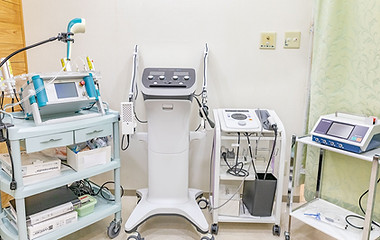Photodynamic Therapy
What is Photodynamic Therapy?
Photodynamic Therapy (PDT) is a treatment in which a photosensitive substance that has the property of collecting in tumor tissue and new blood vessels is administered to the patient, and the area where the photosensitive substance has collected is irradiated with laser light, causing a photochemical reaction in the photosensitive substance, generating active oxygen that has a cytotoxic effect, and degenerating and necrosing the cancer cells.
* Photoimmunotherapy is a treatment that combines photodynamic therapy and immunotherapy.
Features of Photodynamic Therapy
1. Minimally invasive treatment (treatment that places less strain on the body)
There is no need to make an incision in the body, and there is no need to use burdensome anesthesia such as general anesthesia during treatment.
2. Almost no damage to normal cells
Because the drugs act specifically on cancer cells, treatment can be carried out while protecting healthy cells.
3. It can be performed as an outpatient treatment
There is no need for hospitalization and no sacrifice of daily life.
Please avoid sun exposure for about a week after treatment.
Photodynamic Therapy Precautions
Photodynamic therapy requires the administration of a photosensitive substance. However, a drawback of this photosensitive substance is that when exposed skin on the face, hands, etc. is exposed to sunlight or other light other than laser light, it can cause a chemical reaction, resulting in photosensitivity such as redness, rash, and blisters in that area.
Limitations of Photodynamic Therapy
The light required to activate most photosensitizers cannot penetrate more than one-third of an inch (1 cm). For this reason, photodynamic therapy is usually used to treat tumors that are just under the skin or in the epithelium of internal organs and cavities. Larger tumors are less effective because the light cannot penetrate deep into the tumor. Photodynamic therapy is a localized treatment and cannot be used to treat metastatic cancer.
About Photoimmunotherapy
At our clinic, we do not only use sonodynamic therapy alone, but also perform photoimmunotherapy using selected wavelengths of laser, near-infrared light, and ultrasound, or in combination, according to the patient's condition and type of cancer. We use different devices for irradiation methods according to the patient's condition, such as intradermal irradiation, intravascular irradiation, and external point or surface irradiation. By using near-infrared light and ultrasound, we can also treat deep cancers that are difficult for light to reach.

Cost (private medical treatment)
1 session 330,000 yen (tax included)
